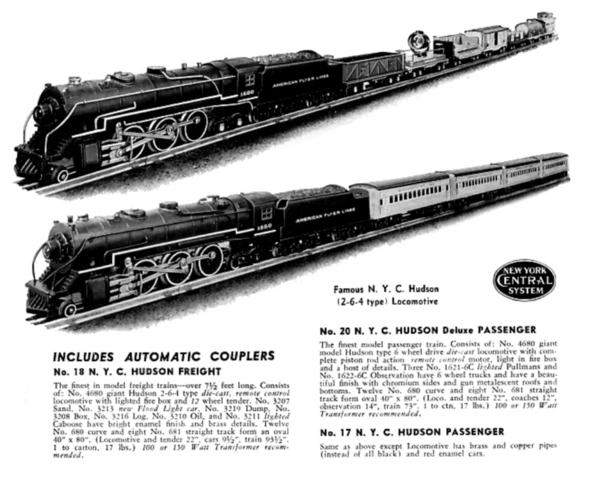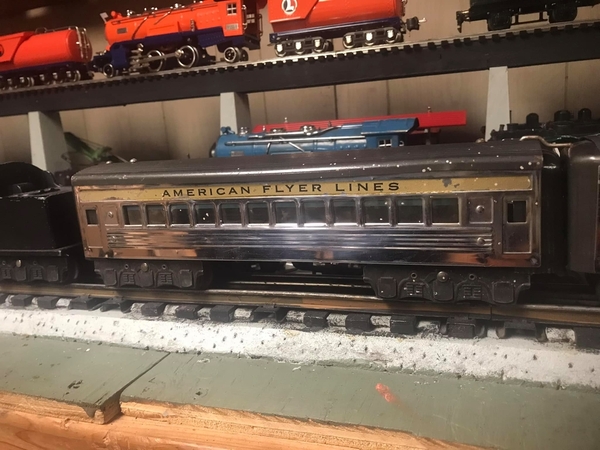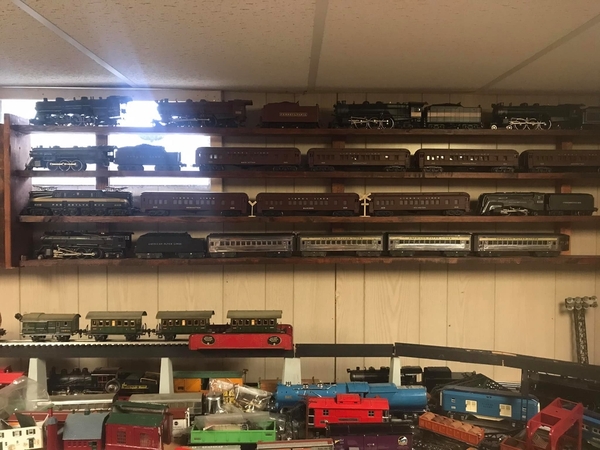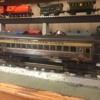Since posting about my repair and slight restoration of a 1680 Hudson from 1938 raised a number of questions about the American Flyer Hudsons, I thought I would post the differing variations of these engines.
The engines pictures are 100% original, with the exception of leading and trailing wheels and the picture of the 1938-1939 motor, which has 2 new drive wheels.
The 1680 was introduced in 1936 and that version features a number of differences from the later versions
The 1936 version features the streamline tender with whistle. This is the only version that features the whistle, due to a patent infringement lawsuit raised by Lionel. However, there are some other minor differences as well.
Note the unusually long and oddly shaped drawbar on the tender. This drawbar is correct for the Hudson only, as the 1936 Hudson tender attaches to the trailing truck.
Note the 1936 trailing truck features a pin extending upward near the center top of the truck. This is where the tender attaches. Additionally, note the trailing truck features 2 wheels only. The forward journal box is for decoration only and like the Hiawatha truck, does not feature a hole for an axle in this position.
Also note the short rim/flange on the drive wheel. The short rim/flange drive wheels are 1936 versions only (for Hudson, Hiawatha, UP City of Denver, and other locomotives with the tall drive wheels).
The 1937 Hudson got a new cast aluminum tender with coal load, tall rim drivers, and 4 wheel trailing trucks.
Note the green stripe on the tender. The tender lettering is the main method of dating the tenders. 1937 only gets the green stripe decal.
Note both the 1936 and 1937 versions have gray cab windows.
The tender has a more normal looking drawbar that connects to the rear of the cab.
Since 1938 marks a number of changes, including ownership of the company, it should be noted that the motors change slightly between the 1936-37 versions and 1938-39 versions. Below is a 1936-1937 type motor.
Note the rear of this motor is clean with no attachments. The reverse unit for the 1936-37 motors are a pendulum type reverse unit, which has a lockout that slides up and down, between the rear and middle drive wheel, a moveable pendulum at the top of the field at the center, and an attached pendulum at the front of the motor, contained in the box attached to the front of the motor.
The 1938-1939 motor is pictured below
Note the 1938-1939 motor still has the box at the front, where the pendulum reverse unit would be on the earlier motors, but it no longer has a mechanism. The reverse unit is now attached to the rear of the motor. This is a 1939 model, which has a lockout that is below the unit and sticks out the side of the body. The nickel plated bracket below the reverse unit is the bracket that holds the motor into the body and essentially requires removal to get the motor out of the body.
The following is my 1680 Hudson that came with my 4 chrome cars.
Note the engine has a 1680 decal below the cab window, instead of the American Flyer decal found on earlier versions. The cab window is red in 1938, instead of the gray color of the earlier versions. The drive wheels also have a white stripe. Additionally, all of the trim is painted black. I noted that the bell on this engine is black below, so I suspect that someone cleaned the paint off of it at some point in its past.
Note the 1938 tender has white lettering on it. This lettering is a decal with a clear background and white letters.
Below is the 1939 version
Note the 1939 version is all black, with no coloring to the cab window or white stripe along the cat walk. The engine is also now lettered 447, with silver rubber stamping, instead of a decal.
The tender also receives silver rubber stamped lettering in 1939.
The only other thing that is different between the 1938 and 1939 versions, is that there are now either freight tenders or passenger tenders, as Gilbert began changing the couplers used on freight cars, first to a sheetmetal type knuckle coupler in 1938 and then to the link couplers in 1939.
Hope this helps to clarify the differences between the various 1680 - 447 Hudsons.
NWL









































